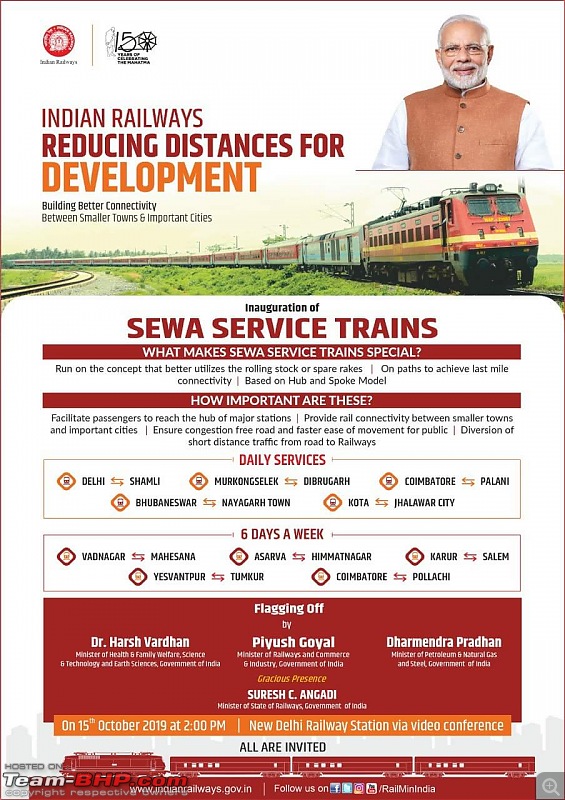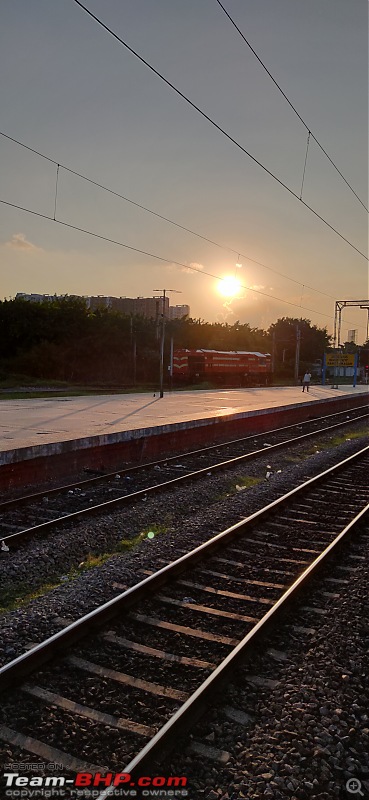Team-BHP
(
https://www.team-bhp.com/forum/)
- -
Railway Pics
(
https://www.team-bhp.com/forum/commercial-vehicles/75014-railway-pics-56.html)
Quote:
Originally Posted by unk9ja
(Post 4661073)
A pic of Bhatkal railway station.
|
Captures the essence of Konkan Railway. Sheer beauty on display, especially during this time of the year.

A new initiative by IR. If a similar model can be implemented for suburban areas within a city similar to Bengaluru, the roads will be free from private vehicles and cabs.
Byappanahalli hosur omalur electric traction charging notification.
Anyone aware of how this works? Once charged and validated electric trains can start or some further process is there before it is ready for operation.
Edit: not sure of it has been done all the way to Omalur yet. Or only till hosur.
Quote:
Originally Posted by Rajeevraj
(Post 4694248)
Anyone aware of how this works? Once charged and validated electric trains can start or some further process is there before it is ready for operation.
|
Once charged, it is supposed to be in charged state. But what I've come to know is that it may not have current all the time. Because there were many instances of copper wire theft when the routes around my city were
charged. Also, there is need for CRS inspection and various other aspects before a go ahead is given. Initial trials are by goods train only and then passenger trains start after some days.

In the sunset, stands a ALCO from Kazipet. Awaiting it's own day into the sunset
Quote:
Originally Posted by Rajeevraj
(Post 4694248)
Byappanahalli hosur omalur electric traction charging notification.
Edit: not sure of it has been done all the way to Omalur yet. Or only till hosur.
|
It's only done upto to Hosur now. Work is in progress beyond Hosur towards Salem.
From a recent news report, electric trains, mainly MEMU services will start by Feb-March.
I did a train ride upto to Hosur and back a month ago and the electrification is on full swing. The ramp from Baiyapanahalli to Salem line had just poles when I was on the train, now the wires are up. The metro work can be seen as well in the first video.
I had done a trip to Salem on this line sometime after it was converted to BG, it is a scenic line after Hosur, especially the ghats nearing Omalur. Now with electrification, that charm will be lost.
https://www.youtube.com/watch?v=0VdxL1WpL2Q https://www.youtube.com/watch?v=YCDpzHjBwQQ&t=105s
Random click of Carmelaram Railway station on the Bangalore Hosur line. Having been visiting this station for the past 10 years. From no basic features to now resembling a decent station with 2 platforms, lighting, lot of seating, refreshment stall, foot overbridge and now the almost ready electric traction. As a railfan been a good journey to observe. :)
With its proximity to Sarjapur Road and the tech cluster on ORR resulting in increasing patronage hope things will improve further and the proposed doubling will happen soon with increased frequency of services.
Folks
A quick question.
I read somewhere that shutting off a diesel locomotive and then turning it on would require about 70 L of diesel. That is why they are kept running idle at stations. The other reason is once the engine is shut down, the oil would drain back to the sump and for it to lubricate the engine parts (given the size of the engine), it would take about 15-20 min.
Correct me if I am wrong
Quote:
Originally Posted by suresh_gs
(Post 4706272)
Folks
A quick question.
I read somewhere that shutting off a diesel locomotive and then turning it on would require about 70 L of diesel. That is why they are kept running idle at stations. The other reason is once the engine is shut down, the oil would drain back to the sump and for it to lubricate the engine parts (given the size of the engine), it would take about 15-20 min.
Correct me if I am wrong
|
You are correct, shutting down an engine and restarting it needs a large amount of fuels and engines do need to be kept on to generate power for the compressor and other auxiliaries. But to avoid this the ALCO's which are rebuilt in the middle of their lives are equipped with Auxiliary Power Units to prevent idling the main engine.
Quote:
Originally Posted by DrPriyankT
(Post 4706280)
You are correct, shutting down an engine and restarting it needs a large amount of fuels and engines do need to be kept on to generate power for the compressor and other auxiliaries. But to avoid this the ALCO's which are rebuilt in the middle of their lives are equipped with Auxiliary Power Units to prevent idling the main engine.
|
Why would it take so much fuel to start an engine? Could you elaborate please? Thanks.
Jeroen
Quote:
Originally Posted by Jeroen
(Post 4706298)
Why would it take so much fuel to start an engine? Could you elaborate please? Thanks.
Jeroen
|
Even i personally don't know why it takes so much fuel. Someone more knowledgeable than me can please answer this.
Quote:
Originally Posted by suresh_gs
(Post 4706272)
Folks
A quick question.
I read somewhere that shutting off a diesel locomotive and then turning it on would require about 70 L of diesel. That is why they are kept running idle at stations. The other reason is once the engine is shut down, the oil would drain back to the sump and for it to lubricate the engine parts (given the size of the engine), it would take about 15-20 min.
Correct me if I am wrong
|
Not anymore.
Loco's are shut down as soon as they are parked at their sidings and started probably 20-30 mins before they need to run. Part of IR's fuel saving.
I remember, Karnataka express dual ALCO's used to be running in idle from the time they reach Bangalore City around 2pm to 7pm when it returns.
Those were old gen loco's and probably there was a reason to leave them running.
I know shutting down and starting these engines take time and is not a quick process. With the EMD's, being a two stroke, probably reaches operating temp's quicker and also automatically increases the pressure in the air tanks for the brakes, by revving the engine on its own.
The shunting loco's at stations and yards are left running for obvious reasons.
Quote:
Originally Posted by DrPriyankT
(Post 4706308)
Even i personally don't know why it takes so much fuel. Someone more knowledgeable than me can please answer this.
|
Quote:
Originally Posted by tharian
(Post 4706320)
Not anymore.
Loco's are shut down as soon as they are parked at their sidings and started probably 20-30 mins before they need to run. Part of IR's fuel saving.
I remember, Karnataka express dual ALCO's used to be running in idle from the time they reach Bangalore City around 2pm to 7pm when it returns.
Those were old gen loco's and probably there was a reason to leave them running.
I know shutting down and starting these engines take time and is not a quick process. With the EMD's, being a two stroke, probably reaches operating temp's quicker and also automatically increases the pressure in the air tanks for the brakes, by revving the engine on its own.
.
|
I am not familiar with trains as such. But these sort of engines are very similar to what is being used in the marine industry to power small ships or used as auxiliary engines on larger vessels.
Typically these engine do need pre-lubricating prior to starting them. If you are unlucky its by means of manual pump. Which could take 5-10 minutes. Very often it is just a small electric powered pump that runs of the battery. Faster and pushing a button is a lot less strenuous than swinging the handle of a manual pump.
On ships we would also turn the engine one or two full turns (2 versus 4 stroke). Each cylinder head would have a valve that was left open to let the air out (and cooling water if you're unlucky). Again, it could be a manual process, or with a little electric or pneumatic motor that does the turning. Not sure if that is the practice with trains.
Diesels, especially modern one, hardly warm up whilst idling. In fact letting them idle away whilst still cold means relative high wear, especially on piston rings and cylinder liners. It is very often the oil that takes the longest to reach operating temperature. Not sure about train engine, but on ships there are system to keep the oil at operating temperatures with the engine shut down. Or do a pre-heat of the oil, especially in low temperature environments. Maybe that is what takes the extra fuel?
Air pressure could be a thing of course and I assume they need to get their air vessels topped up prior moving.
Excluding time to pre-heat, lubricating, turning checking, starting a diesel engine like this in marine applications it could take from a few minutes to 10-15 depending on the circumstances and procedures they use.
Not sure what happens on trains though, would love to hear!
Jeroen
| All times are GMT +5.5. The time now is 22:37. | |


